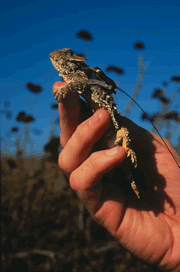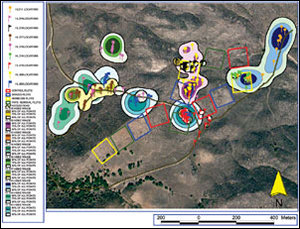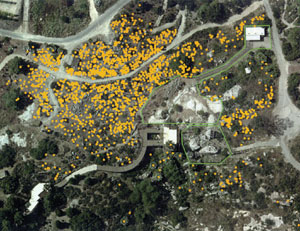ArcView generated graphic comparing habitat usage of San Diego coast horned lizards on control and restored coastal sage scrub plots in southern California. |
If you're like a lot of people, you probably have trouble telling the difference between a calliandra and a callistemon. Don't feel bad. "What plant is that?" is the most frequently asked question at botanical gardens and arboretums. And now it's getting easier to find the answer thanks to GIS.
The Zoological Society of San Diego has extensive plant and animal collections at its 100-acre San Diego Zoo and the San Diego Wild Animal Park, an 1,800-acre wildlife preserve near Escondido, California. These sites serve as the foundation for its work in reproduction, protection, and preservation of animals, plants, and habitats.
Dr. Allison Alberts, head of the Applied Conservation Division at the Zoological Society of San Diego's Center for Reproduction of Endangered Species (CRES), which does habitat conservation research and manages species recovery programs for the society, says interest in GIS was evolving in different parts of the society at the same time and eventually a users group was started. "The pathologists were thinking about using GIS to study epidemiological issues, and the plant folks independently wanted to find a way to catalog and map the plant collection," says Alberts. "We were also thinking about how we could use this technology in our endangered species programs. We started meeting on a regular basis internally, and when we realized that we had this shared interest, we started looking at how to best move forward."
The users group knew the society could benefit by implementing several GIS applications and set out to acquire the necessary hardware and software. Since 1999, it has been working with ArcView 2.x and is now upgrading to ArcView 8. Currently, there are five users in the organization. Two people had prior GIS experience and the others had received Web-based training.
The Zoological Society of San Diego has extensive plant and animal collections at its 100-acre San Diego Zoo and the San Diego Wild Animal Park, an 1,800-acre wildlife preserve near Escondido, California. These sites serve as the foundation for its work in reproduction, protection, and preservation of animals, plants, and habitats.
Dr. Allison Alberts, head of the Applied Conservation Division at the Zoological Society of San Diego's Center for Reproduction of Endangered Species (CRES), which does habitat conservation research and manages species recovery programs for the society, says interest in GIS was evolving in different parts of the society at the same time and eventually a users group was started. "The pathologists were thinking about using GIS to study epidemiological issues, and the plant folks independently wanted to find a way to catalog and map the plant collection," says Alberts. "We were also thinking about how we could use this technology in our endangered species programs. We started meeting on a regular basis internally, and when we realized that we had this shared interest, we started looking at how to best move forward."
The users group knew the society could benefit by implementing several GIS applications and set out to acquire the necessary hardware and software. Since 1999, it has been working with ArcView 2.x and is now upgrading to ArcView 8. Currently, there are five users in the organization. Two people had prior GIS experience and the others had received Web-based training.
 A San Diego coast horned lizard. | |
"There's been a lot of hands-on training, too," says Alberts. "There are a number of people who, just through hands-on work, have been able to apply ArcView to their own projects, and they are continuing to learn new things as they see how the program can be applied."
Helping the Snakes
The Wild Animal Park also contains 900 acres of pristine undeveloped land where researchers are using GIS to track the local red diamond rattlesnake. Snakes are important for controlling rodent species. Sometimes they show up in the various animal exhibits, and they have to be relocated.
"We're tracking where they go because some studies suggest that when rattlesnakes are moved, they don't do well—they don't know where to go and can't find their dens for the winter," explains Alberts. "The study is to find out how well the translocated snakes fare. We've found that as long as you move them about one-half mile or less, they seem to do well. They move around a bit more than the resident snakes but they settle into a home range and find overwinter sites. The survival rate has been good." The researchers are determining spatial limitations and will be able to make management recommendations to the public so that snakes are not immediately killed when they turn up in backyards.
Mapping the Botanical Collections
Nowadays, many public gardens are using GIS not only to help identify, label, and monitor plant material but also to maintain specific planting areas and manage irrigation systems.
"The society's plant inventory project began as part of a requirement for accreditation with the American Association of Museums," says Joseph Betzler, CRES plant conservation specialist. For accreditation with the American Association of Museums, plant collections must be labeled and inventoried. Three of the Wild Animal Park's most valuable collections—the Baja California Garden, Conifer Arboretum, and California Nativescapes Garden—have already been identified and cataloged with GIS. The work is ongoing since plant collections need to be reassessed regularly.
The Baja collection was amassed over several years during trips with permits to Baja California and is among "the most important collections this society has," according to Betzler. Old hand-drawn maps of the area were replaced a few years ago with aerial photo-based maps, which were rectified to the baseline state coordinate system. A team of three working with a Trimble GPS unit and a data logger then worked to create the inventory of the three gardens. In addition to each plant's location, its genus and species, comments about the condition of the specimen, its growth pattern, and other features were noted in the database.
It took several months to catalog the more than 4,000 plants in the three gardens that cover more than a dozen acres. For the Baja collection, Betzler says, "We started planning it in January and did the siting in the spring. Among the logistical considerations was making labels for each plant and creating a database of questions that were answered on the portable unit as we did the inventory."
The field data was loaded into the GIS along with the aerial photographs. Users can locate specific plants or all the plants of a particular species. As the data is updated, staff members will be able to monitor the growth, relocation, and distribution of the plant material. Betzler says that being able to locate specific plants and provide accurate accounts of specimens is particularly important to scientists who come to the society to do research. "If a scholar or student comes to the park to study a particular plant, we can generate a map and show that person where to find all those plants," he says. Before the GIS implementation, researchers would have to generate lists or maps on their own.
"The society's plant inventory project began as part of a requirement for accreditation with the American Association of Museums," says Joseph Betzler, CRES plant conservation specialist. For accreditation with the American Association of Museums, plant collections must be labeled and inventoried. Three of the Wild Animal Park's most valuable collections—the Baja California Garden, Conifer Arboretum, and California Nativescapes Garden—have already been identified and cataloged with GIS. The work is ongoing since plant collections need to be reassessed regularly.
The Baja collection was amassed over several years during trips with permits to Baja California and is among "the most important collections this society has," according to Betzler. Old hand-drawn maps of the area were replaced a few years ago with aerial photo-based maps, which were rectified to the baseline state coordinate system. A team of three working with a Trimble GPS unit and a data logger then worked to create the inventory of the three gardens. In addition to each plant's location, its genus and species, comments about the condition of the specimen, its growth pattern, and other features were noted in the database.
It took several months to catalog the more than 4,000 plants in the three gardens that cover more than a dozen acres. For the Baja collection, Betzler says, "We started planning it in January and did the siting in the spring. Among the logistical considerations was making labels for each plant and creating a database of questions that were answered on the portable unit as we did the inventory."
The field data was loaded into the GIS along with the aerial photographs. Users can locate specific plants or all the plants of a particular species. As the data is updated, staff members will be able to monitor the growth, relocation, and distribution of the plant material. Betzler says that being able to locate specific plants and provide accurate accounts of specimens is particularly important to scientists who come to the society to do research. "If a scholar or student comes to the park to study a particular plant, we can generate a map and show that person where to find all those plants," he says. Before the GIS implementation, researchers would have to generate lists or maps on their own.
A Work in Progress
Betzler and his colleagues are also using GIS for other projects. One of the first GIS projects was to provide a reliable map and record of the water utilities (including irrigation systems), particularly at the Wild Animal Park where water is a limiting factor and essential to maintaining a healthy plant collection.
Another ongoing GIS project at CRES involves the seed bank, where seeds from San Diego County are collected and preserved. The GIS will be used to keep track of where those seeds came from and all the associated data from the collection. Research seems to show that seeds grow best in the microclimate in which they were collected. The idea is to start a seed bank for material specific to San Diego County, and when developers need to revegetate an area, they will be able to do so with the best genetically adapted material.
"The spatial element is key to the whole premise," says Alberts. "Seed from other places will grow here, but they are not going to do as well as the seeds from here."
Monitoring species distribution patterns—how species populations are affected by environmental conditions—is another area in which GIS is useful. When population numbers of endangered species fall below a certain level or a habitat shrinks to a certain size, species recovery programs are put in place to help those species get back up to stable numbers.
"We are using GIS on those projects to monitor the data that we collect," says Alberts. One project the division is working on involves tracking bighorn sheep that are fitted with radio collars. The researchers are interested in how the animals are using the habitat and what their interactions are with mountain lions, their primary predator, and with mule deer, the other prey of mountain lions. They are looking at the interactions between the three species and entering that data in the GIS database for analysis.
Coast horn lizards are a key animal species dependent on the coastal sage scrub, the local habitat, which has disappeared by more than 80 percent in recent years. Scientists are looking at ways to rid invasive grasses in areas of coastal sage scrub to encourage natural recovery. They have generated control plots and a series of degraded plots where they are using methods to restore the coastal sage scrub and to monitor the restoration and observe whether coast horn lizards are returning.
"The neat thing is that GIS is enabling us to see how much time those horn lizards are spending on the restored plots," says Alberts. The restoration methods appear to be a positive step in restoring the coastal sage scrub habitat and making it usable for the key animal species again.
Betzler's research also involves invasive exotic species. He's recording the perimeter of an invasive population over time with GIS to determine if stands are increasing or decreasing.
Making Things Easier
"One of the huge benefits of GIS is that we now have a variety of ways we can display our data, which helps us not only to see patterns but also to interpret them," says Alberts. "It helps us share with people what we're doing and explain what's happening with a particular species with regard to human use of the habitat. The layering in GIS enables that. It helps people visualize the pattern and understand it at a glance. GIS takes animal tracking to a whole new level because you can actually plot out what animals are doing in reference to other species in the environment."
Alberts says they often use GIS as a public outreach tool, incorporating output from GIS into PowerPoint presentations because it easily makes the point. "It's so visually appealing and easy for people to grasp. It helps us show people what we're doing."
Betzler says as more people within the organization discover the uses for GIS, more requests come in.
For more information, contact Dr. Allison Alberts, head, Applied Conservation Division, the Zoological Society of San Diego (tel.: 619-557-3955, e-mail: aalberts@sandiegozoo.org).
Alberts says they often use GIS as a public outreach tool, incorporating output from GIS into PowerPoint presentations because it easily makes the point. "It's so visually appealing and easy for people to grasp. It helps us show people what we're doing."
Betzler says as more people within the organization discover the uses for GIS, more requests come in.
For more information, contact Dr. Allison Alberts, head, Applied Conservation Division, the Zoological Society of San Diego (tel.: 619-557-3955, e-mail: aalberts@sandiegozoo.org).












0 comments:
Post a Comment